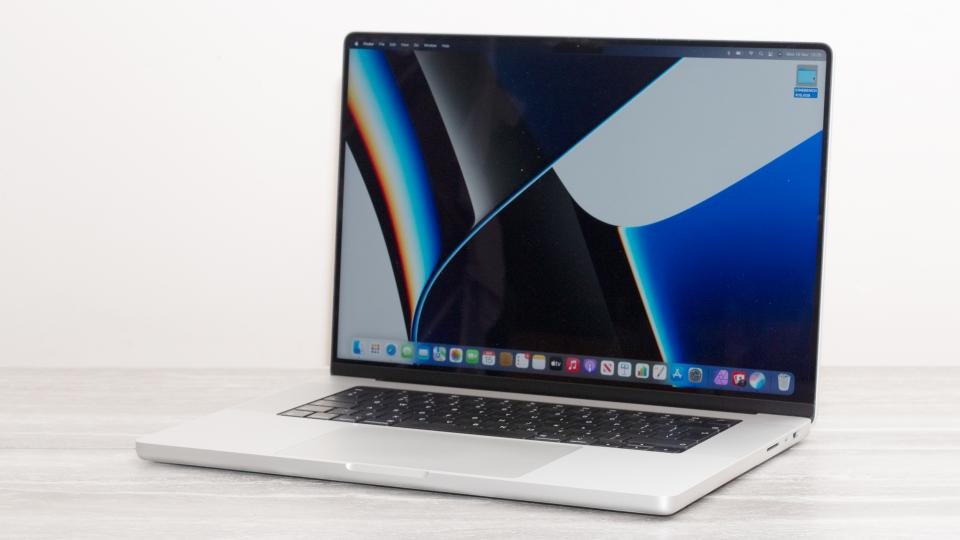
Looking for a new laptop? These are the best models we’ve tested
If you’re after the best laptop money can buy, you’ve come to the right place. We’ve collected all of the best laptops in one place to help you find the perfect machine for your needs in 2022.
Wondering why you should listen to us? Simple. Every year, dozens of the latest and greatest laptops pass through the Expert Reviews labs – along with plenty of not-so-great laptops, too. Each device is subjected to our rigorous in-house testing, so when we recommend a laptop you can be sure of one thing: it’s a laptop we’d be happy to buy ourselves.
Read on and you’ll discover everything from the best business-class laptops to super-sleek ultraportables, gaming laptops and 2-in-1 hybrids. In short, there’s something for everyone. And if you’re really not sure what to go for, our laptop buying guide will point you in the right direction.
Best laptop: At a glance
- Best laptop overall: M1 Apple MacBook Air
- Best Windows laptop: Dell XPS 13 (11th-gen)
- Best budget laptop: Huawei MateBook D15
- Best for power users: Asus ROG Zephyrus G15
- Best Windows 2-in-1 laptop: Microsoft Surface Pro 8
How to choose the best laptop for you
Buying a brand-new laptop is no easy task. There are so many brilliant devices to choose from each year, with prices ranging from £200 to £2,000 or more. Cost can also vary massively between different configurations of the same laptop, which only adds to the confusion. In this brief buying guide, we’ll help you make the right choice by outlining the most important factors to consider before you bust out the bank card.
What do you need your laptop for?
Your personal requirements should dictate what sort of laptop you go for. A typical university student will have different tech needs to a professional video editor. Some may need a laptop that can process large files at rapid speeds, while others may just want to use Google Docs or browse the web. Ultimately, it all comes down to what you want your laptop to do.
What about performance and battery life?
The most powerful laptops are those with the most powerful CPUs and the highest amount of RAM. A laptop’s CPU power is measured in gigahertz (GHz), and each processor has a baseline frequency as well as a maximum frequency. Other factors can impact overall performance, including poor temperature control, which can lead to thermal throttling. Ideally, any laptop you buy should have at least 4GB of RAM as a minimum. Processors aren’t as easy to pin down – they might be dual-core, quad-core or hexa-core and can range greatly in power.
An Apple MacBook Pro (or Windows equivalent such as the Dell XPS 15) has a much more powerful CPU and more RAM than a cheap Chromebook because people expect them to run multiple demanding applications.
Battery size is measured in milliamp-hours (mAH) or Watt-hours (Wh) – the biggest battery will (in theory) last the longest, but it all depends on how much power the various components inside the device use (the display, CPU and GPU have the biggest impact). An ultra-budget laptop with a small battery size may last longer than a premium notebook with a huge battery because its internal hardware isn’t as demanding. We run a standardised video rundown test on every single laptop we review, with the longest-lasting performers tending to be a mix between efficient high-end ultraportable laptops and low-powered Chromebooks.
What operating system should you go for?
Whether it’s Windows, macOS or Chrome OS, each operating system has its own strengths and weaknesses. macOS is only found in Apple’s own laptops, while Windows powers all sorts of laptops from manufacturers such as Acer, Asus and Lenovo. Google’s low-powered Chrome OS is also rising in popularity and can be found on a wide range of devices.
What’s the best display resolution?
When it comes to laptop displays, the resolution isn’t everything. If the same laptop has the option of a Full HD (1,920 x 1,080) display and a 4K (3,840 x 2,160) display, the latter is usually more expensive but not necessarily sharper. How sharp a display look depends on two factors: the size of the screen and how far away you sit from it.
In our experience, you don’t really need more than 1,920 x 1,080 on a screen 14in or smaller. In fact, if you have 20/20 vision, you’d have to be viewing the display at a distance closer than 56cm. Given that laptops with higher-resolution panels typically suffer a bit in the battery life department, it’s often worth opting for the lower resolution, and cheaper, option if you can.
The quality of a laptop’s display has little to do with the resolution of the screen, however. There’s no guarantee of a laptop’s maximum brightness, colour accuracy or contrast ratio no matter how sharp it is. We measure all these when testing each laptop because a dim, muddy or washed-out display can ruin a great product.
How many ports should a laptop have?
In addition to a power socket and headphone jack, most new laptops will come with at least one USB-C and a couple of USB-A ports. When it comes to connections, the general rule of thumb is the more the merrier.
It’s worth paying attention to the type of USB-C ports you’re getting, however; although they might look the same, they often have different capabilities from machine to machine. For the fastest transfer speeds, look for Thunderbolt 3 USB-C ports; USB-C isn’t as quick.
And don’t assume every USB-C port on a laptop can carry video, power and data. Although the standard allows for this, manufacturers sometimes limit what each port can do.
It’s extremely useful to have a full-sized HDMI connector for hooking up the laptop to additional monitors, too, although these aren’t particularly common on slimmer laptops. And an SD card reader doesn’t hurt, either – an addition that’s sorely lacking on Apple’s laptops these days.
The best laptops you can buy in 2022
1. Apple M1 MacBook Air: The best laptop overall
Price: £887 | Buy from John Lewis
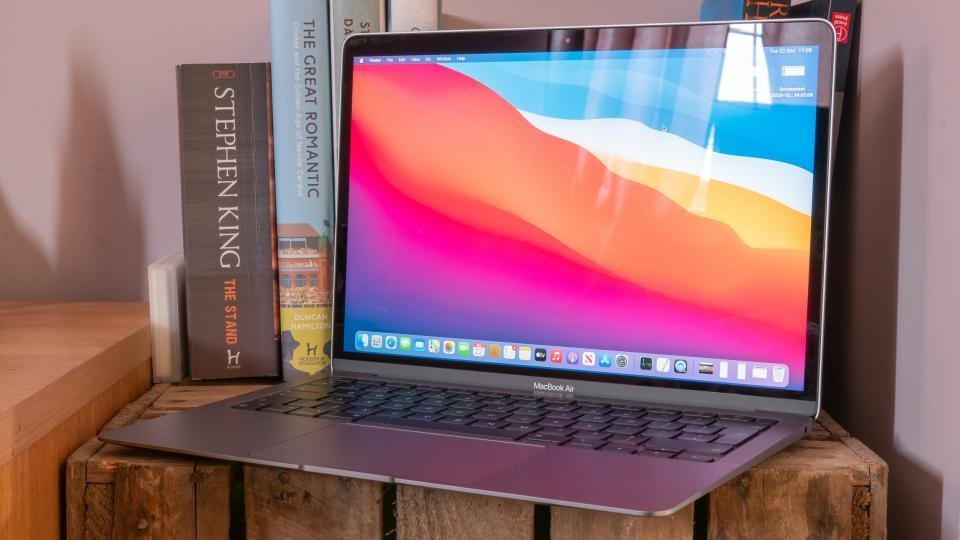
Apple’s latest laptop breaks away from the Intel processors of old, and the result is a spectacularly good laptop. With the Apple M1 chip onboard, the new MacBook Air outperforms most Intel-based Windows rivals at a similar price, has better battery life and it’s fanless as well so doesn’t whine irritatingly when it’s working hard.
It isn’t radical in any other way – it looks exactly like previous MacBook Air laptops – but that great performance, coupled with a superb keyboard and touchpad and a brilliant display, make this a laptop that’s impossible to beat, especially at the £999 price for the base model. It’s so good that we fully expect the M1 MacBook Air to remain our favourite laptop until the next model is released.
Read our full M1 Apple MacBook Air review for more details
Key specs – Display size: 13.3in; Resolution: 2,560 x 1,600; Type: IPS; CPU: Apple M1; Graphics: Apple M1; RAM: 8-16GB; Storage: 256GB-2TB; Dimensions: 304 x 212 x 16.1mm (WDH); Weight: 1.29kg
2. Samsung Galaxy Book Pro 15.6: The best-value AMOLED laptop
Price: From £1,049 | Buy from Amazon
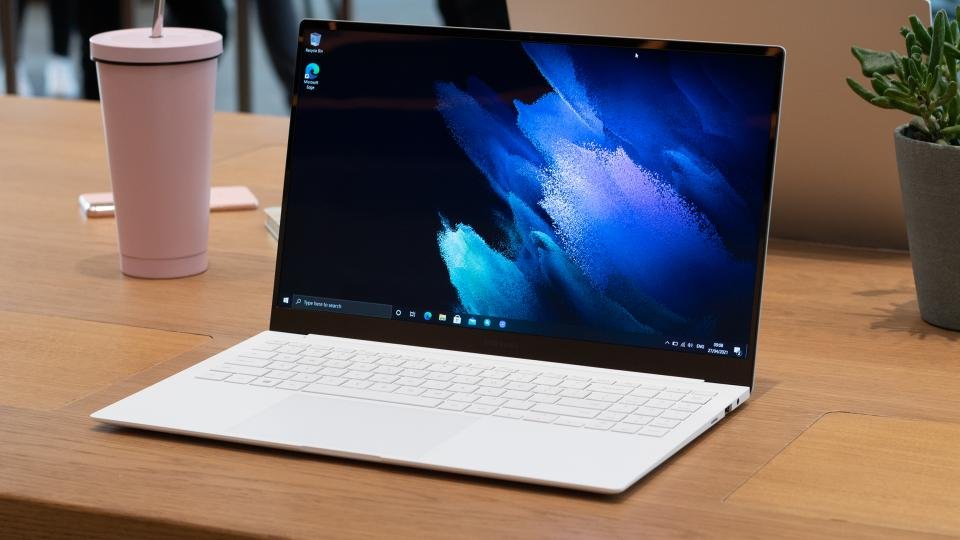
Following hot on the heels of the M1 MacBook Air is the Windows 10-based Samsung Galaxy Book Pro. This laptop might not be quite as speedy as Apple’s finest but it has plenty else to recommend it.
For starters, it’s incredibly light: a weight of only 1.05kg for the 15.6in model is simply stunning and more than 2kg lighter than the smaller 13.3in MacBook Air.
It’s also the cheapest laptop we’ve come across to come with a vibrant AMOLED display. The resolution is limited to 1080p, so it isn’t as sharp as some rivals, but that’s a compromise we’re happy to live with when a display looks this good.
Top that off with superb battery life and a great keyboard and you have one of the best laptops you can buy today. With prices starting at £1,199 for the 11th-gen Core i5 version, it’s also very good value for money.
Read our full Samsung Galaxy Pro review for more details
Key specs – Display size: 15.6in; Resolution: 1,920 x 1,080 (non-touchscreen); Panel type: AMOLED; CPU: Intel Core i5-1135G7 or i7-1165G7; Graphics: Intel Iris Xe; RAM: 8GB or 16GB; Storage: 256GB or 512GB NVMe SSD; Dimensions (WDH): 355 x 226 x 11.7mm; Weight: 1.05kg
3. Dell XPS 13 (11th-gen): The best Windows laptop
Price: From £1,020 l Buy now from Dell
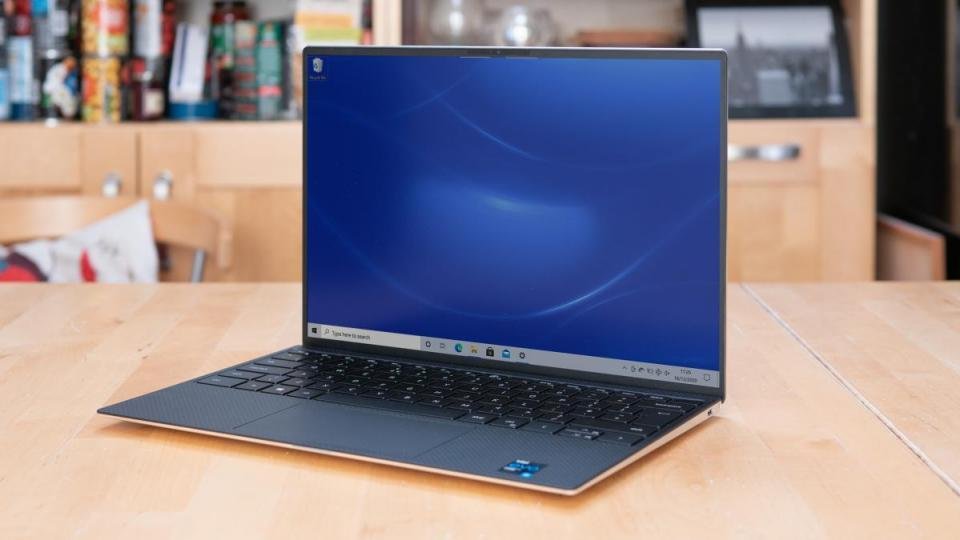
Dell updates its XPS laptops twice a year these days in lockstep with Intel’s CPU upgrades, and the latest model has Intel’s 11th-gen CPUs as an option. As with previous XPS 13 editions, the late-2020 model is a laptop that gets pretty much everything right, from the brilliant build quality and colour-accurate display to the fabulous keyboard and a generous specification for the money.
As ever, there’s an XPS 13 for most budgets. You can choose from various combinations of specifications, including an Intel Core i5-1135G7, a Core i7-1165G7 or a Core i7-1185G7 CPU, 8GB, 16GB or 32GB of RAM and a 512GB or 1TB PCIe SSD.
With improved performance across the board, including better battery life and significantly faster graphics scores, the Dell XPS 13 remains the Windows 10 ultraportable to beat, although it’s fallen behind the M1 MacBook Pro and Air laptops for outright bang per buck.
Read our full Dell XPS 13 review for more details
Key specs – Display size: 13.4in; Resolution: 1,920 x 1,200 (non-touchscreen) or 3,840 x 2,400 (touchscreen); Panel type: IPS; CPU: Intel Core i5-1135G7, Intel Core i7-1165G7 or Intel Core i7-1185G7; Graphics: Intel Iris Xe; RAM: 8GB/16GB/32GB; Storage: 512GB/1TB; Dimensions: 296 x 199 x 14.8mm (WDH); Weight: 1.2kg (non-touchscreen) or 1.27kg (touchscreen)
4. Huawei MateBook D15 (2021): The best budget laptop
Price: £750 | Buy now from Huawei
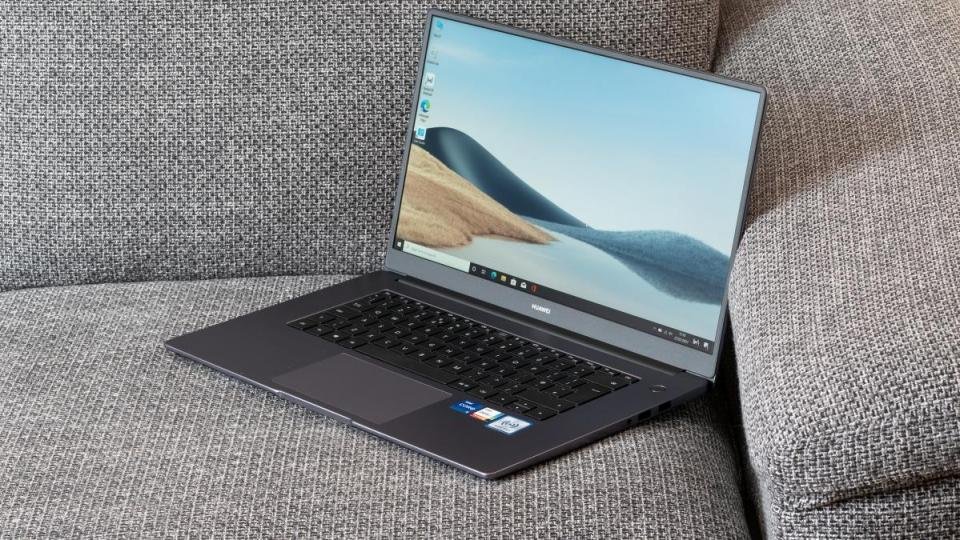
Despite a price increase in 2021, the Huawei MateBook D15 remains one of the best no-frills laptops on the market. Nothing has changed from the 2020 model in terms of design – the D15 is lightweight, compact and handsome thanks to its rigid aluminium chassis. The connection options at your disposal are unchanged too, with three USB-A ports and a single USB-C port accompanied by an HDMI port and 3.5mm audio jack.
When it comes to performance, however, the 2021 D15 leaves its predecessor in the dust. The new 11th-gen Core i5 processor is a big step up from the AMD CPU that powered the 2020 iteration and achieved the highest score we’ve ever recorded for a Core i5 machine during our in-house 4K media benchmark test. Battery life has also seen an increase of over an hour, while the 512GB Samsung-made SSD achieved solid read and write speed scores during testing.
Sadly, Huawei hasn’t updated what is a disappointingly dim display and still insists on hiding the webcam in an awkward spot under a fake key between F6 and F7. But if you’re willing to overlook those issues, you’ll be getting a very competent laptop for a very reasonable price.
Read our full Huawei MateBook D15 (2021) review for more details
Key specs – Display size: 15.6in; Resolution: 1,920 x 1,080; Type: IPS; CPU: Intel Core i5-1135G7; Graphics: Intel Iris Xe; RAM: 8GB; Storage: 512GB SSD; Dimensions: 358 x 230 x 17mm (WDH); Weight: 1.57kg
5. Huawei MateBook 14s: The best-value premium ultraportable
Price: £849 | Buy now from Amazon
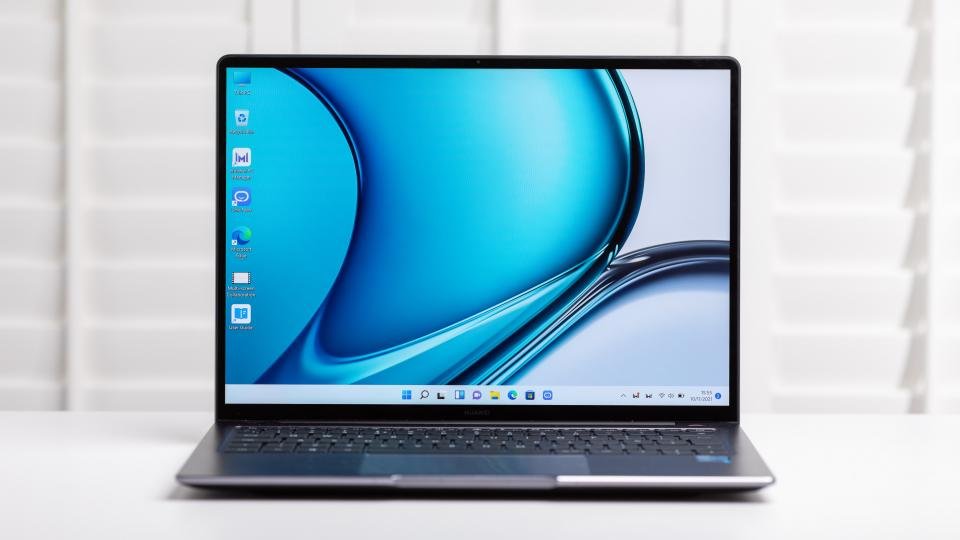
Huawei has a history of producing top-quality, great-value compact laptops but it has surpassed itself this time around. The MateBook 14s is well made, performs superbly and, best of all, Huawei has finally removed the webcam from the keyboard and put it in a more sensible place at the top of the display.
Not only that but the display sees an upgrade to 90Hz and, coupled with the Intel Core i7-11370H CPU, it’s a very strong rival to the M1 Apple MacBook Air. At this price, with a 512GB SSD and 16GB of RAM, the MateBook 14s is a brilliant laptop.
6. Microsoft Surface Pro 8: The best Windows 2-in-1 laptop
Price: From £949 | Buy now from Amazon
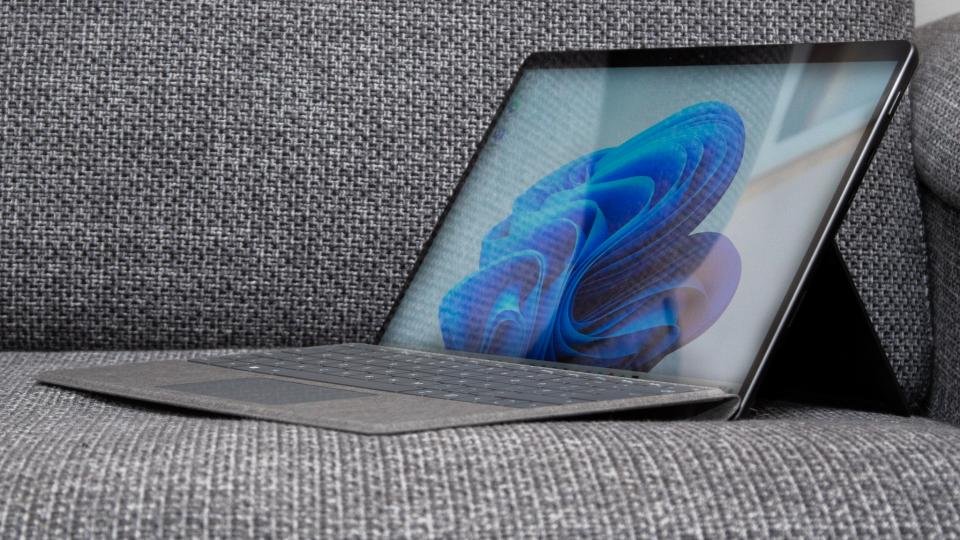
The Surface Pro has been the flag-bearer for 2-in-1 laptops ever since it was first devised; in recent times, however, Microsoft has neglected it somewhat, upgrading the CPU but regularly but little else.
The Surface Pro 8, however, is the redesign Surface fans have been waiting for. It has a new chassis that’s sleeker than before, a new Signature Keyboard and Surface Slim Pen 2 and, of course, Microsoft has updated the internals as well to give customers a choice between the Intel Core i5-1135G7 and the i7-1185G7.
The core strengths remain in place. The 3:2 touchscreen is sublime and the keyboard and touchpad are a delight to use.
You still have to pay extra (£160) for the keyboard and even more for the Surface Slip Pen 2 but that seems to be the way of things amongst premium 2-in-1 devices these days. If you can stomach that, this is the king of Windows 2-in-1 laptops and it should be at the very top of your shortlist.
Read our full Microsoft Surface Pro 8 review for more details
Key specs – Processor: Intel Core i5-1135G7 or i7-1185G7; RAM: 8GB, 16GB or 32GB; Storage: 128GB, 256GB, 512GB or 1TB SSD; Screen resolution: 2,880 x 1,920; Weight: 890g (tablet), 1.2kg (with Signature Keyboard)
7. Lenovo Yoga Slim 7 (AMD): The best-value Windows laptop
Price: £800 | Buy now from Amazon
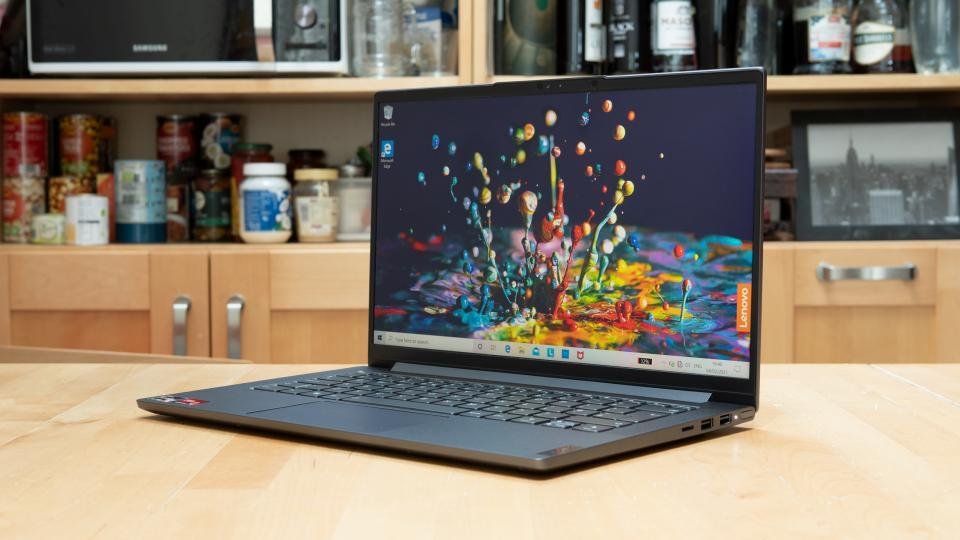
Lenovo has forgotten more about making laptops than some other manufacturers will ever know, and this ultra-compact notebook is a great demonstration of that expertise. For a comparatively low price, you’re getting a seriously powerful processor, excellent speakers, a very good keyboard and a solidly designed aluminium body.
Powered by an octa-core AMD Ryzen 7 4700U processor, the Yoga Slim 7 performed exceptionally in our benchmark tests. For a ULV (ultra-low voltage) processor, the AMD Ryzen 7 4700U is a beast. The laptop’s integrated Radeon RX Vega 8 GPU is no slouch either, running through the opening levels of Doom at an average of 28fps at 1,920 x 1,080 and 59fps at 1,280 x 720.
The laptop is also available with an Intel Core i7 CPU but, since it costs extra and the Ryzen 7 laptop is so good anyway, we recommend sticking with the AMD model.
With a keyboard flanked by two Dolby Atmos-branded speakers, the Lenovo Yoga Slim 7 is also one of the best-sounding compact laptops we’ve encountered. Taken along with its 14in, 1,920 x 1,080 IPS display, Lenovo’s offering makes for a convincing do-it-all laptop that won’t break the bank.
Read our full Lenovo Yoga Slim 7 (AMD) review for more details
Key specs – Display size: 14in; Resolution: 1,920 x 1,080; Type: IPS; CPU: AMD Ryzen 7 4700U; Graphics: Radeon RX Vega 8; RAM: 8GB; Storage: 128GB-1TB SSD; Dimensions: 321 x 208 x 14.9mm (WDH); Weight: 1.4kg
8. Apple MacBook Pro 16in (2021, M1 Pro): A powerhouse laptop with great battery life
Price: From £2,150 | Buy now from Amazon

Apple’s M1 processors go from strength to strength in the 2021 MacBook Pro range of laptops and the 16in is quite simply the best all-round portable computer we’ve reviewed. It comes with the barnstormingly quick Apple M1 Pro processor inside, from 16GB to 64GB of RAM and SSDs ranging from 512GB to a huge 8TB in capacity.
Its 16.2in, 120Hz ProMotion mini-LED display is the real star of the show, however. With peak brightness of up to 1,600cd/m2, black response levels nearly as good as an OLED screen, and a choice of professional-level colour calibrations to choose from, it’s the best screen we’ve ever seen on a laptop.
Not only that, but Apple has brought back the HDMI port and SD card slot for this edition, and it has banished the Touch Bar in favour of a full-sized function key row and a lovely large Escape key.
Prices start at £2,399, which means this powerhouse won’t be for everyone. However, if you’re a creative professional in need of serious computing power on the move, there is no better laptop.
Read our full Apple MacBook Pro 16in review for more details
Key specs – Display size: 16.2in; Resolution: 3,456 x 2,234 (254ppi); Type: mini-LED; CPU: Apple M1 Pro or M1 Max; Graphics: 16-core (M1 Pro) or 32-core (M1 Max); RAM: 16GB, 32GB or 64GB; Storage: 512GB, 1TB, 2TB, 4TB or 8TB SSD; Dimensions: 356 x 248 x 17mm (WDH); Weight: 2.1kg (M1 Pro), 2.2kg (M1 Max)
9. Asus Zephyrus G15: The best Windows laptop for power users
Price: £2,599 | Buy now from Argos
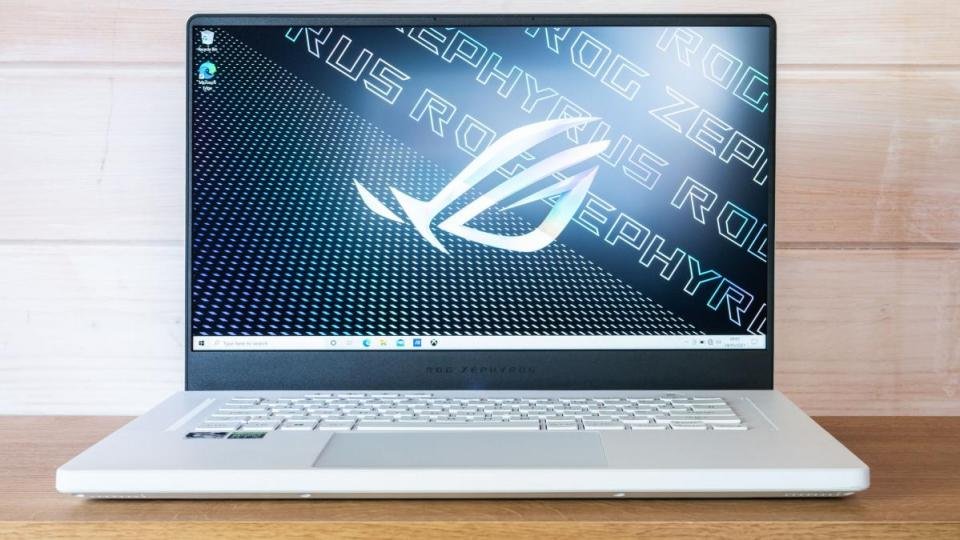
Asus has been knocking out high-power gaming laptops like there’s no tomorrow recently and every one of them has been impressive. The Zephyrus G15, however, is the most impressive of the lot, especially if you don’t get on with the unapologetic gamer aesthetic of the Asus Strix Scar 15.
It comes with a stunning 165Hz QHD display and a full array of top-flight componentry — the model we reviewed came with an AMD Ryzen 5900HS CPU and an Nvidia GeForce RTX 3080 GPU — ensuring that no game or application is beyond it.
And it’s relatively slim, light and compact as well, making it one of the best ever laptops we’ve ever tested for power-hungry users on the move. The catch? Apart from the high price, very little.
Key specs – Screen size: 15.6in; Screen type: IPS; Processor: AMD Ryzen 9 5900HS; Graphics adapter: Nvidia GeForce RTX 3080; RAM: 32GB; Storage: 1TB; Dimensions, mm (WDH): 355 x 243 x 19.9mm; Weight: 1.9kg
10. Razer Book 13: The best laptop for work (and a bit of play)
Price: From £1,099 | Buy now from Amazon
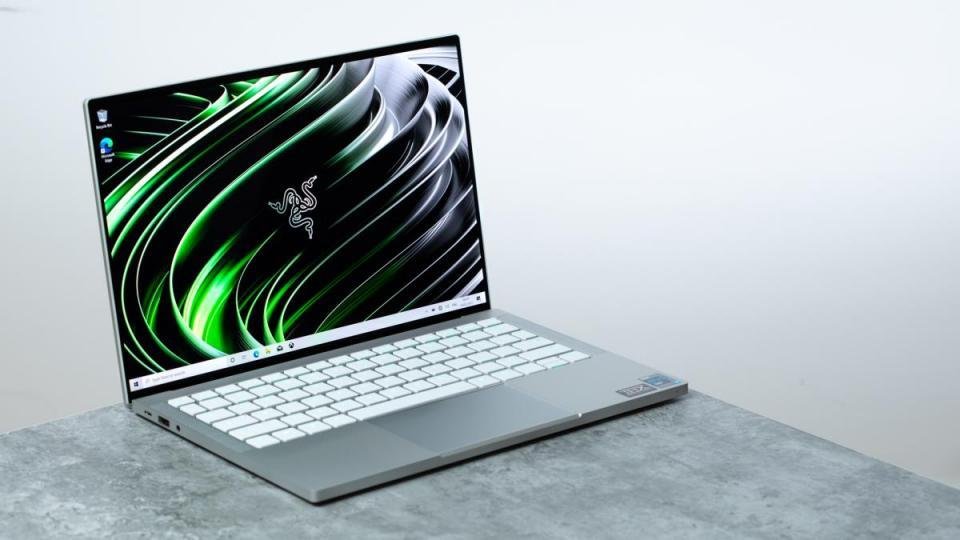
Razer produces some of the best gaming laptops around, but the Book 13 is its first attempt at a device designed for work rather than play. It’s a very successful attempt, too, with impressive build quality complemented by up-to-date internal specifications. The base model houses an 11th-gen Intel Core i5 processor backed by 16GB RAM, while there are also Core i7 variants available, one of which features a 4K screen.
We tested a Core i7 model with an FHD display and it performed well across our range of in-house tests, although it couldn’t quite match the scores posted by the M1 MacBook Air and Lenovo Yoga Slim 7. It does house two USB-C ports, however, and also manages to squeeze a USB-A 3.1 port, HDMI 2.0 port and MicroSD slot into its compact form. Razer hasn’t completely abandoned its gaming roots, though, as evidenced by the Book 13’s highly customisable RGB-backlit keyboard, which is mechanically excellent and a joy to type on.
It may be new to the world of ultraportable productivity laptops, but Razer has hit the ground running with a work device capable of competing with the very best on the market.
Read our full Razer Book 13 review for more details
Key specs – Display size: 13.3in; Resolution: 1,920 x 1,080 (non-touch and touch) or 3,840 x 2,160 (touch); Type: IPS; CPU: Intel Core i5-1135G7 or Intel Core i7-1165G7; Graphics: Intel Iris Xe; RAM: 16GB; Storage: 256GB SSD; Dimensions: 296 x 199 x 15mm (WDH); Weight: 1.4kg
11. HP Envy 13: The best sub-£1,000 laptop with a discrete GPU
Price: £750 | Buy now from HP
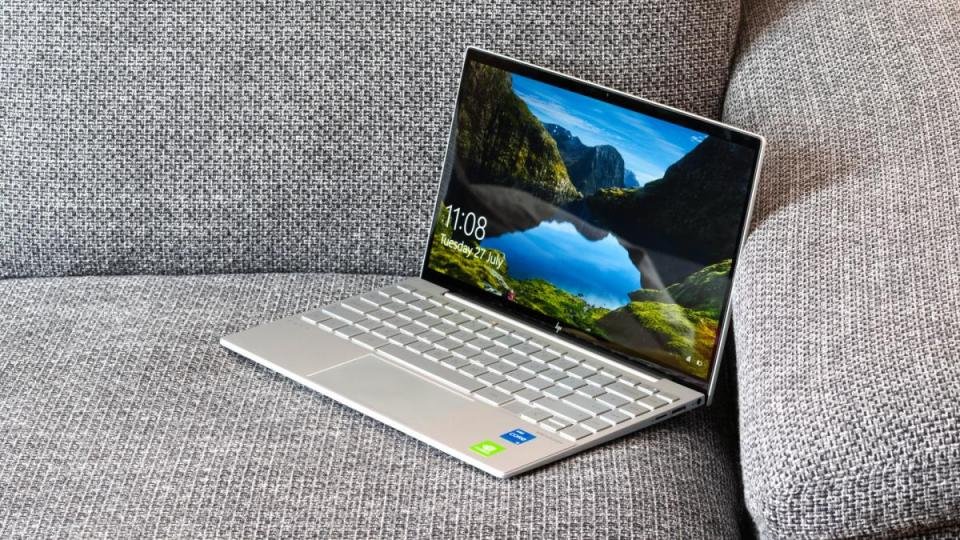
Ultra-compact laptops housing discrete GPUs are a rare find under £1,000, but the HP Envy 13 manages to squeeze an Nvidia GeForce MX450 graphics chip into what is a very appealing package.
The 11th-gen Intel Core i5 processor powering the Envy 13 ensures it’s up to speed with its similarly priced competitors, while the 13.3in touchscreen sports impressive contrast, decent brightness and commendable colour accuracy.
Battery life is good too, but it’s the MX450 GPU that really sets the Envy 13 apart from its rivals, allowing the device to sustain some pretty serious gaming and excel at intensive tasks such as video rendering. If either of those activities are high on your list of laptop requirements, the Envy 13 is hard to beat in the sub-£1,000 price bracket.
Read our full HP Envy 13 review for more details
Key specs – Display size: 13.3in; Resolution: 1,920 x 1,080 (touchscreen); Type: IPS; CPU: Intel Core i5-1135G7; Graphics: Nvidia GeForce MX450; RAM: 8GB; Storage: 512GB SSD; Dimensions: 306 x 194 x 16.9mm (WDH); Weight: 1.3kg
12. Asus ROG Strix Scar 17 (2022): The best gaming laptop
Price: £2,500 | Buy now from Amazon
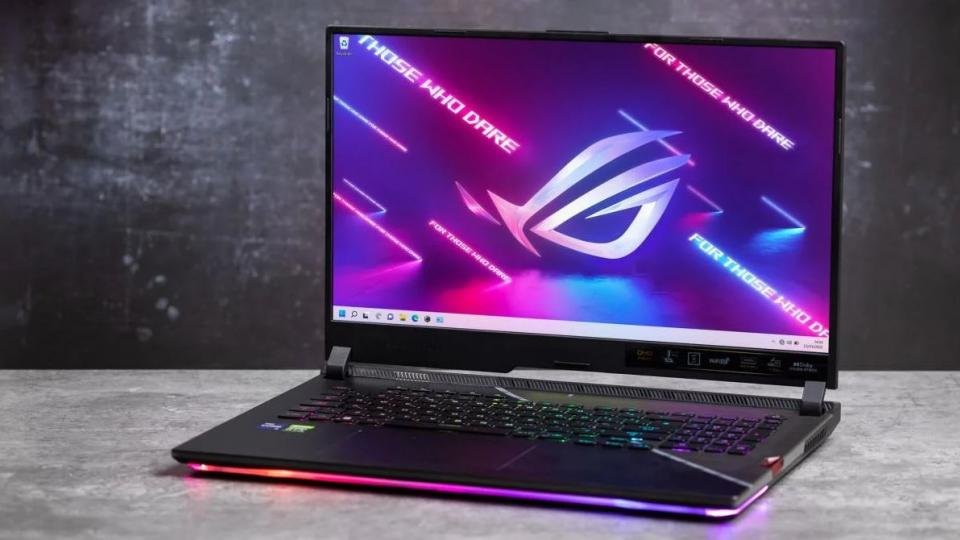
The Asus ROG Strix Scar 17’s combination of a 12-generation Intel Alder Lake processor and an Nvidia GeForce RTX 3070 Ti GPU blasts all of its gaming laptop rivals out of the water.
As well as traditional RGB LEDs around the front, it boasts per-key lighting and you can put the laptop into Turbo mode via Asus’ KeyStone dongle. You’re getting plenty of ports, including USB-C, along with expandable internal storage via the empty SSD bay. Meanwhile, the chiclet-style keyboard is as satisfying to use and comes with five handy hotkeys.
The 2,560 x 1,440 IPS display is excellent, with a 240Hz refresh rate and a maximum brightness of 309cd/m². Colours are rich and vivid, while there are eight display profiles that are tailored for everything from racing games to first-person shooters. Elsewhere, the speakers provide a punchy sound and a battery life of 7hrs 15mins in our video-rundown test is decent for such a behemoth.
As for performance, the Scar 17 made mincemeat of our benchmarks. It was the first laptop to exceed the 500-point barrier in our media test, beating the second-place Acer Helios 500 by a vast 150 points. In our gaming-specific tests, it took running demanding titles in its stride and even managed 98fps at Wolfenstein: Youngblood’s toughest possible settings. Those are brilliant totals.
Other gaming laptops with 12-generation Intel chips will be released soon, but the Asus ROG Strix Scar 17 is currently the best gaming laptop you can buy.
Read our full Asus ROG Strix Scar 17 review for more details
Key specs – Display size: 17.3in; Resolution: 1,560 x 1,440; Type: IPS; CPU: Intel Core i9-12900H; Graphics: Nvidia GeForce RTX 3070 Ti; RAM: 32GB; Storage: 2TB SSD; Dimensions: 395 x 282 x 234mm (WDH); Weight: 2.9kg
13. LG Gram 17 (2021): The best big-screen laptop
Price: £1,199 | Buy now from Amazon
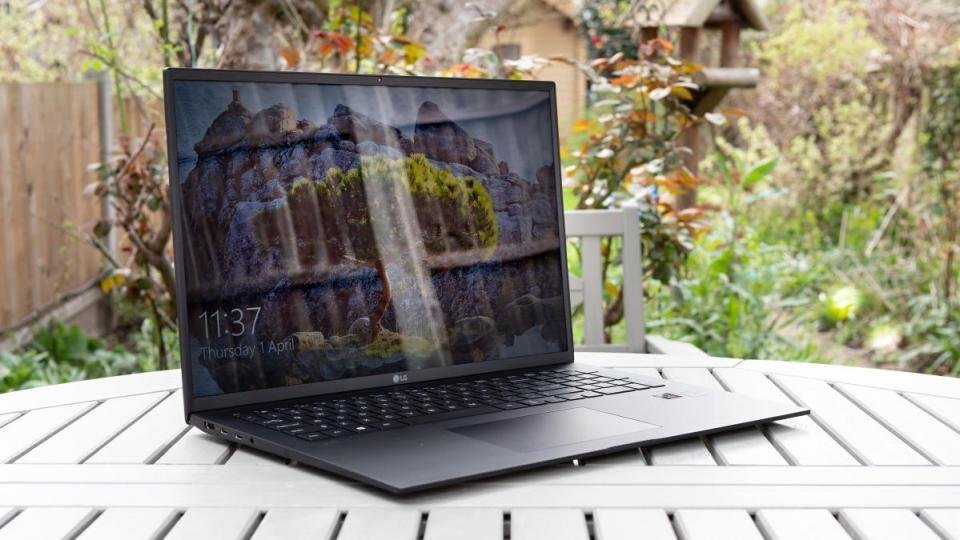
The 2021 refresh of LG’s ultra-lightweight 17in laptop is even better than the 2020 model, which is no mean feat. The latest iterations house 11th-gen Intel processors and these provide a healthy boost to performance and battery life. We tested the Core i7/16GB RAM version and it proved significantly faster than the 2020 model, while battery life clocked in at 13hrs 24mins – around two-and-a-half hours longer than its predecessor.
LG has made a few other notable tweaks, too. The Gram 17 now charges via USB-C and looks better thanks to a rougher matte finish and more angular chassis. The keyboard has also undergone a makeover and now includes a number pad and a larger touchpad, while the keys are slightly bigger and have less space between them. These changes help deliver an improved typing experience, although it still can’t quite match that of the MacBook Air or Dell XPS 13.
The 17in IPS display remains the star of the show, covering over 100% of the DCI-P3 colour gamut with excellent accuracy. The 16:10 aspect ratio screen is sharp and spacious to work on, and a polarising layer helps reduce reflections while using the Gram 17 outdoors.
If you’re after a large-screen laptop, you simply can’t beat the LG Gram 17. It weighs the same as most 13.3in devices and can handle pretty much any task thrown at it. If you can live with a 16in screen, we recommend you check out the Gram 16, which offers a very similar experience but is slightly cheaper.
Read our full LG Gram 17 (2021) review for more details
Key specs – Display size: 17in; Resolution: 2,560 x 1,600; Type: IPS; CPU: Intel Core i5-1135G7 or i7-1165G7; Graphics: Intel Xe; RAM: 8/16GB; Storage: 512GB/1TB; Dimensions: 381 x 263 x 17.4mm (WDH); Weight: 1.35kg
14. Microsoft Surface Laptop 4 13.5in: Quick, ultraportable and beautifully designed
Price: From £941 | Buy now from Amazon
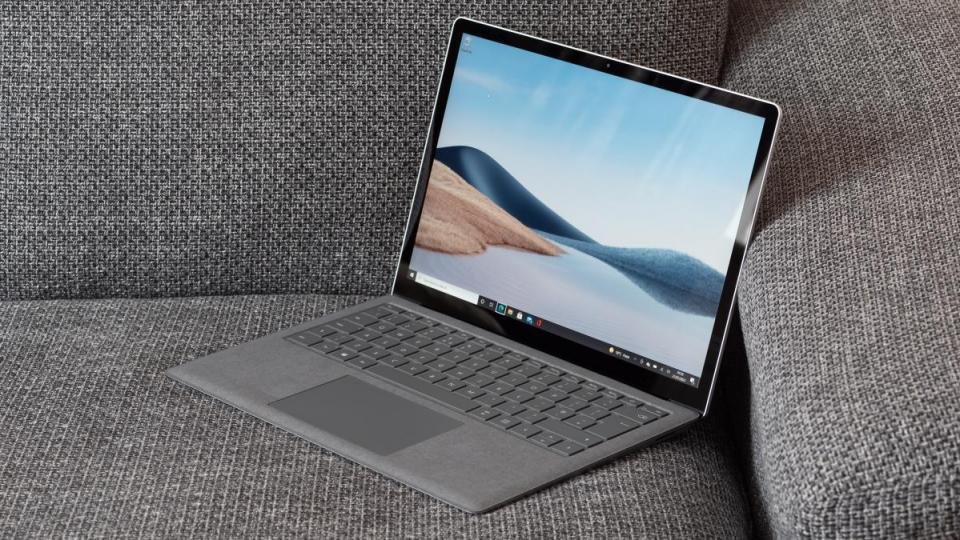
The latest Surface Laptop won’t win any awards for innovation – it’s essentially exactly the same laptop as its predecessor but with updated internals – but it’s still a great device that pushes our favourite laptop, the M1 MacBook Air, close on a number of fronts. In fact, when it comes to its display and its result in our 4K media benchmark test, the Surface Laptop 4 has Apple’s offering beaten.
Available in a range of configurations housing both AMD and Intel processors, the Surface Laptop 4 is both beautifully designed and practical to use. It’s lightweight, the keyboard has a three-stage backlight and is a joy to type on, while the trackpad is decent, too. The 13.5in touchscreen covers over 95% of the sRGB colour gamut with excellent accuracy, the 3:2 aspect ratio is more practical than most of its rivals and the display is bright enough for use in most lighting conditions.
Battery life lags behind a number of the other entries on this list and graphics performance leaves a bit to be desired, but as a day-to-day machine for work, the Microsoft Surface Laptop 4 is a very attractive choice.
Read our full Microsoft Surface Laptop 4 13.5in review for more details
Key specs – Display size: 13.5in; Resolution: 2,256 x 1,504; Type: IPS; CPU: AMD Ryzen 5 4860U; Graphics: AMD Radeon; RAM: 8GB; Storage: 256GB SSD; Dimensions: 308 x 223 x 14.5mm (WDH); Weight: 1.27kg
15. Dell Inspiron 15 7000: The best-value 2-in-1 laptop
Price: From £829 | Buy now from Dell
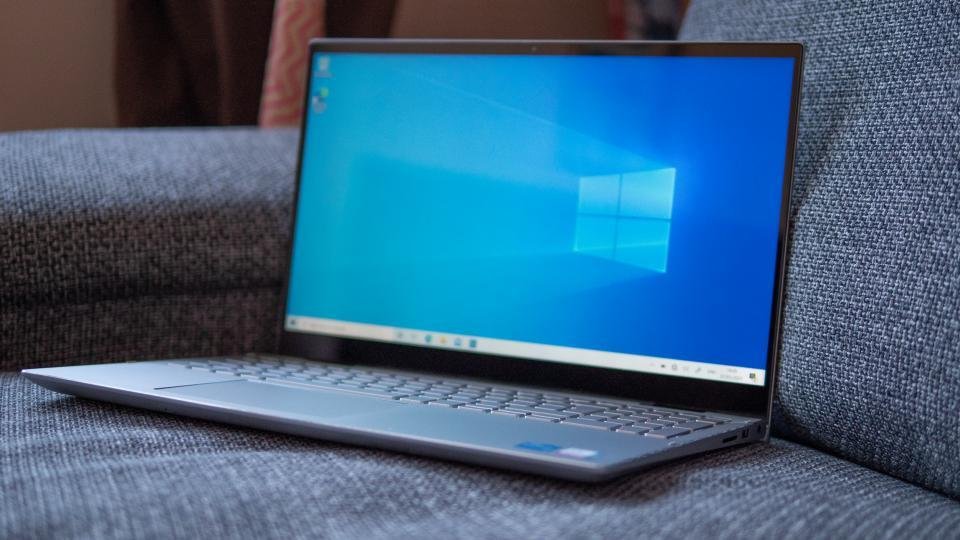
Offering big-screen thrills for a sub-£1,000 price, this convertible laptop from Dell is an excellent mid-range machine. It sits neatly between Dell’s workaday Inspiron 5000 series and its more expensive XPS range, managing a compelling combination of value for money, power, convenience and style.
Its 2-in-1 design lets you fold the Dell Inspiron 15 7000 through 360 degrees into a “tent” mode that functions much like a touchscreen tablet. It looks smart and stylish and feels well made, although the keyboard is fair-to-middling rather than outstanding. This can be forgiven, though, when you consider the other strengths of Dell’s machine.
Performance, for example, punches well above its weight, and is more than up to the job of doing anything 99% of laptop users will require – and doing it quickly. It’s also chock full of ports, including a much desired USB-C connector that supports Thunderbolt 4, Power Delivery and DisplayPort. Taken all together, along with a modest price tag, and you get great value for money.
Read our full Dell Inspiron 15 7000 review for more details
Key specs – Display size: 15.6in; Resolution: 1,920 x 1,080 or 3,840 x 2,160; Type: WVA; CPU: 11th-gen Intel Core i5-1135G7 or Core i7-1165G7; Graphics: Intel Iris Xe; RAM: 12-16GB; Storage: 512GB-1TB PCI-E NVMe SSE; Dimensions: 359 x 224 x 20mm (WDH); Weight: 2kg
